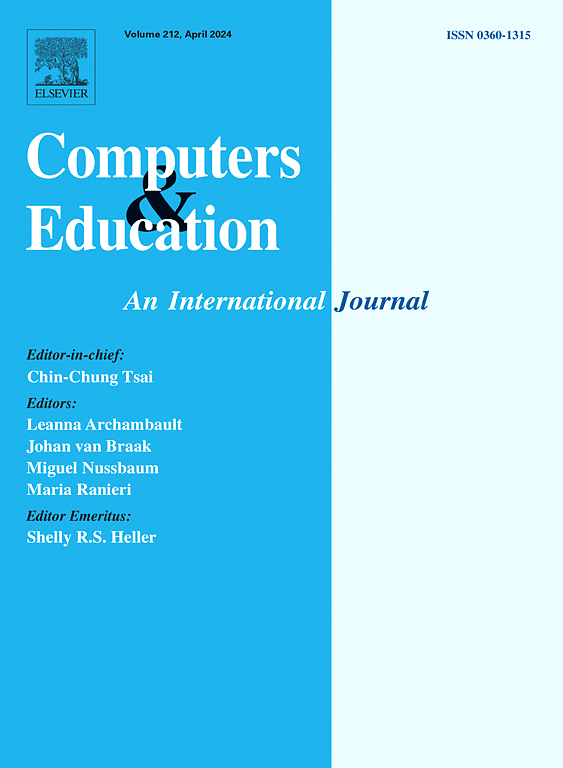Can AI support human grading? Examining machine attention and confidence in short answer scoring
IF 8.9
1区 教育学
Q1 COMPUTER SCIENCE, INTERDISCIPLINARY APPLICATIONS
引用次数: 0
Abstract
Large language models built upon artificial intelligence (AI) hold great promises to innovate automatic short answer scoring (ASAS) - significantly alleviating educators’ workload in assessing student answers. However, ASAS systems on such basis have seen limited adoption in authentic teaching environments due to the models’ inability to explain the predictions they generate. To address this, we recruited 32 human graders to comparatively analyse the decision-making processes of human graders and AI-driven graders. Specifically, we exploited two types of data to holistically unveil the decision-making processes of human graders throughout grading, namely manual annotation of important words and gaze data of the human graders. The decision-making processes of AI-driven graders were revealed by important words extracted though eXplainable Artificial Intelligence technique and grading confidence reflected by the prediction probability distributions. We measured the alignment in their decision-making regarding their (i) estimated scoring difficulty, (ii) important text segments and (iii) crucial grammatical categories to enhance the transparency and trustworthiness of AI-driven graders. Subsequently, we conducted randomised control studies, presenting machine-extracted insights like important words and estimated scoring difficulty to scrutinise how they affected human grading. Our findings contribute new knowledge regarding the consistency between human and machine scoring and validates machine-extracted insights, such as important words and scoring difficulty, to be valuable in facilitating human grading, encouraging the adoption of ASAS systems and urging the potential collaboration between machine and human grading in pedagogical practices. However, we emphasised the significance of grasping question context and intricacy before leveraging such machine-extracted insights.
人工智能能支持人类评分吗?检查机器的注意力和信心在简短的回答评分
基于人工智能(AI)的大型语言模型在创新自动简答评分(ASAS)方面有着巨大的前景——大大减轻了教育工作者评估学生答案的工作量。然而,基于这种基础的ASAS系统在真实教学环境中的采用有限,因为模型无法解释它们产生的预测。为了解决这个问题,我们招募了32名人工评分员,对比分析人工评分员和人工智能评分员的决策过程。具体来说,我们利用两类数据,即人工标注的重要词和人类阅卷者的注视数据,来整体揭示人类阅卷者在整个阅卷过程中的决策过程。通过可解释人工智能技术提取的重要词汇和预测概率分布反映的评分置信度,揭示了人工智能驱动评分的决策过程。我们测量了他们在决策方面的一致性,包括(i)估计的评分难度,(ii)重要的文本段和(iii)关键的语法类别,以提高人工智能驱动的评分者的透明度和可信度。随后,我们进行了随机对照研究,呈现机器提取的见解,如重要单词和估计评分难度,以仔细检查它们如何影响人类评分。我们的发现提供了关于人类和机器评分之间一致性的新知识,并验证了机器提取的见解,如重要单词和评分难度,在促进人类评分,鼓励采用ASAS系统以及敦促机器和人类评分在教学实践中的潜在合作方面具有价值。然而,我们强调了在利用这种机器提取的见解之前掌握问题背景和复杂性的重要性。
本文章由计算机程序翻译,如有差异,请以英文原文为准。
求助全文
约1分钟内获得全文
求助全文
来源期刊

Computers & Education
工程技术-计算机:跨学科应用
CiteScore
27.10
自引率
5.80%
发文量
204
审稿时长
42 days
期刊介绍:
Computers & Education seeks to advance understanding of how digital technology can improve education by publishing high-quality research that expands both theory and practice. The journal welcomes research papers exploring the pedagogical applications of digital technology, with a focus broad enough to appeal to the wider education community.
 求助内容:
求助内容: 应助结果提醒方式:
应助结果提醒方式:


